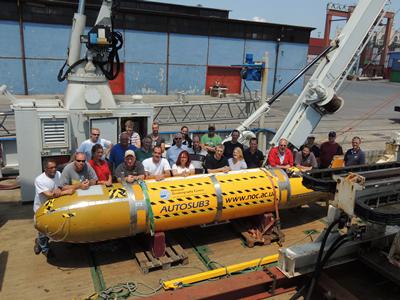Daring underwater mission reveals how deep ocean floor currents can travel thousands of kilometres

An international team of scientists, including Dr Esther Sumner from Ocean and Earth Science and Prof Stephen Darby from Geography and Environmental Sciences, has discovered how giant density-driven submarine flows are able to travel thousands of kilometres into the deep ocean.
In their findings, published in Nature Communications, the team coupled detailed flow measurements, made with marine robotic technology, with advances in fluid dynamics. The results show that, despite forming spectacular channels on the seafloor (thousands of miles long in some cases), previous theory that considers density-driven flows as underwater rivers is flawed and instead these flows have more in common with jet streams in planetary atmospheres.
The team’s research findings are critical for understanding the hazards that these flows can pose to critical seafloor infrastructure, such as submarine telecommunications cables, which carry over 95% of global internet traffic, as well as oil and gas pipelines.
Previous theory had been limited because of the difficulties in measuring these flows in the deep ocean, meaning past research on density-driven flow dynamics has largely been based upon the use of idealised laboratory and numerical models.
The international research team, which included scientists from the Universities of Leeds, Hull and Southampton, the Middle East Technical and the Istanbul Technical Universities, as well as the UK’s National Oceanography Centre, made their breakthrough by investigating the dense salty water spilling over from the Mediterranean into the comparatively fresh waters of the Black Sea, via the Bosphorus Strait.
The density-driven Black Sea flow is focussed through a channel on the sea floor and transports 22,000 cubic metres of water every second – a volume comparable to some of the largest rivers on Earth. The team measured the density-driven flow in unprecedented detail by a daring mission that involved flying a 2.4 tonne, 7-metre-long Autonomous submarine (Autosub3) at speeds up to 10 km per hour, less than 5m above the seafloor, enabling instruments on the submarine to image the flow in unprecedented detail.
Dr Esther Sumner said: “Our field measurements deliver a true step-change, as the level of detail provided by the field data shows that these density-driven flows have much higher levels of physical complexity than was previously understood. By demonstrating self-organisation of the flow, and thus a stable mechanism for reducing mixing with the surrounding water, we are now able to explain how density-driven flows travel so far.”
Professor Steve Darby said: “There has been more attention given to the channels on Mars than to the sea-floor channels that are scoured by density-driven flows, despite their important role in transporting carbon, nutrients and heat across the ocean floor. Our research explains for the first time how these massive flows are able to travel such vast distances.”

